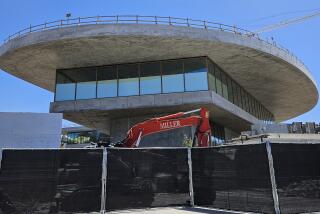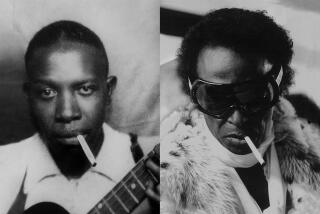Museum of Moving Art
- Share via
New York--Day after day, rain or shine, dozens--sometimes hundreds--of the faithful stand in line outside the Museum of Modern Art. Never mind that a new exhibition hasn’t opened for three months, or that the special attraction at the moment is a retrospective of paintings by German artist Gerhard Richter, whose name is hardly a household word. This is the world’s foremost museum of modern and contemporary art--and people have to see it. So they wait--chatting, reading newspapers or checking out merchandise in the windows of the museum bookstore as they shuffle along East 53rd Street. Now and then, someone bolts across the street, grabs a fresh crepe or canned soda from a sidewalk stand, then slips back into the line.
But the ritual is coming to an end. On May 21 at 5 p.m., the 73-year-old museum will close its doors for three years. Fulfilling a long-term, $800-million expansion plan, a new landmark will rise on MoMA’s historic site. Designed by Japanese architect Yoshio Taniguchi, the 630,000-square-foot structure will incorporate elements of the existing building while nearly doubling in size. When the museum reopens in 2005, it will have a new seven-story gallery tower, an education and research center, a soaring atrium and a dramatic lobby with a view of the restored Abby Aldrich Rockefeller Sculpture Garden. The original 53rd Street entrance will be retained, but visitors can also enter through new doors on 54th Street.
For the record:
12:00 a.m. May 19, 2002 For The Record
Los Angeles Times Tuesday May 14, 2002 Home Edition Main News Part A Page 2 A2 Desk 1 inches; 24 words Type of Material: Correction
Museum location-A story about the Museum of Modern Art in Sunday Calendar incorrectly gave its location as East 53rd Street. The New York institution is on West 53rd Street.
For The Record
Los Angeles Times Sunday May 19, 2002 Home Edition Sunday Calendar Part F Page 2 Calendar Desk 0 inches; 29 words Type of Material: Correction
Museum location--A story about the Museum of Modern Art in last Sunday’s Calendar should have said the New York institution is on West 53rd Street. The direction was wrong.
What to do in the meantime?
Move and carry on.
“We didn’t want to go out of business for three years,” said Glenn D. Lowry, director of the museum. “On a purely tactical level, we have a lot of great shows that we want to do, and I am not prepared to cede the ground to anyone else. To keep a staff focused and upbeat and committed, you have to give them opportunities to do what they do.
“On a strategic level, this is an incredibly competitive environment in New York,” he said. “While MoMA’s audience is strong and the institution’s identity is clear, being out of the spotlight and the public gaze for three years is a very long time to allow other institutions to erode your audience. That would be a very foolish thing to do.”
But where does a museum with 600 employees and a 100,000-piece collection go while awaiting its grand new home?
To a former Swingline staple factory. In Queens.
The monumental move is already well underway. Even as MoMA visitors peer through windows at construction in the sculpture garden and the adjacent area, where the Dorset Hotel once stood, or peruse a model and a video of the new building in the lobby, trucks pull up at the loading docks and transport art to Queens. On June 29, only six weeks after the building on East 53rd Street closes, a temporary exhibition program will open at MoMA QNS, the official name of the facility in Long Island City, in the borough of Queens.
But that’s merely the public face of the momentous project. Behind the scenes, the museum’s administrators, curators, conservators, registrars and art handlers are engaged in a team effort to close down the old facility and open the new one. The bulk of that effort concerns the museum’s major asset: the art collection. From landmark paintings such as Vincent van Gogh’s “The Starry Night” and Pablo Picasso’s “Les Demoiselles d’Avignon” to contemporary German artist Andreas Gursky’s massive color photograph “Times Square, New York,” every last painting, sculpture, drawing, print, photograph, architectural model and design object must be carefully packed and moved.
“We started moving art at the end of March,” said Jennifer Russell, deputy director for exhibitions and collections support, “and we have to have everything out of the building by Labor Day. It’s an amazing process.”
The key to success is a sheaf of charts tracking the move week by week. Seated at a small table in her office on the museum’s sixth floor, Russell reached over to her desk, plucked a stapled pack of papers from the top of a pile and flipped through the pages. “It’s color-coded by department,” she said. “Solid lines mean packing, dotted lines mean moving, crosses mean unpacking.”
One major challenge was to coordinate all the separate components of the move, she said. Works on paper are packed by an outside firm, Fine Arts Express, and moved from one loading dock; painting and sculpture, packed by the staff, leave from the other dock. The six curatorial departments must proceed “in a certain order to get the collection out of the building,” Russell said. “We couldn’t move prints and drawings until the architecture and design collection was out because we had to go through that space to get to the freight elevator.”
The trucks, which are precisely scheduled, have air-conditioning and high-performance shock absorbers. “One of the problems is that in order for climate control to work in a truck, the engine has to be running,” Russell said. “Having those engines running while the trucks are being loaded really irritates our neighbors, but there’s nothing we can do about it.”
What goes into those trucks has been carefully prepared for the journey to Queens. Paintings with ornate frames are protected by sturdy wood travel frames. Like many other objects, they are encased in Coro-plast, an acid-free plastic sheeting that looks like corrugated milk glass. Strong but lightweight, rigid but easy to cut with a box knife, it provides protection without hiding the contents, said Pete Omlor, manager of art handling and preparation. Mylar windows are set into plastic cases holding particularly fragile objects that require close observation, he said.
Heavy wood crates, like those used to transport art on airlines, are not needed for the short truck trip to Queens in most cases, but everything gets individual attention. Before packing, the condition of each piece is reviewed by a conservator, who advises about suitable packing materials. Small objects are individually wrapped, then grouped together in cardboard boxes. Paper attached to the boxes list works by artist name, title and acquisition number.
The whereabouts of each work is tracked on a computer throughout the move, said Ramona Bannayan, director of collections management and exhibition.
For security reasons, museum officials won’t reveal the trucks’ routes. “We have actually planned the loading of the trucks and their contents until the end, and communications are down to military precision,” Bannayan said. “We did so much planning and preparation in advance that it really has gone very smoothly.”
Although first-time and casual visitors probably don’t know what they are missing, the museum’s exhibition space has shrunk during the past year. The museum’s west and north wings, which housed the education center and galleries for architecture, design, photography, prints and illustrated books, along with stored collections, have already been demolished.
In Omlor’s rudimentary ground-floor office, the phone rings continually and his colleagues frequently stop by to ask quick questions, but everything appears to be under control. All is calm--if only for the moment--in the adjacent warehouse-like space where artworks await transport to Queens. Securely packed paintings stand on racks or lean against walls. Boxes of smaller works are arranged in neat rows.
Five floors above all this activity, Lowry sits in his quiet office, next to a rectangular coffee table covered with short stacks of books. Among them is a slim but lavishly produced silver and red volume, “MoMA Builds,” designed to explain the project to patrons and to solicit their financial support. In a pocket on the back cover of the book is a list of “naming opportunities”--from $25 million for the grand lobby to $5,000 for a seat in the museum’s auditorium.
Reflecting on the massive construction and fund-raising project, Lowry said it is the product of an overarching vision of the museum and its future. Both the expansion and the move to Queens began with discussions about “where we saw ourselves 25 years from now and what we assumed our attendance, collections and agenda would look like,” he said.
Although MoMA’s leading position in modern art is widely accepted, its dedication to contemporary art has been questioned. Lowry rejects that. “We have built over the last 10 or 15 years probably the preeminent collection of contemporary art as well. We just haven’t had space to show it,” he said.
“The most important decision we made was an absolute commitment to continuing the growth of our collection into the present,” continued Lowry, who took charge of MoMA in 1995. “While we were exceptionally strong in the late 19th century right through the 1960s, we wanted to have a collection that moved into the 21st century. That meant we needed space to show different kinds of objects than we have traditionally shown. Large Richard Serra sculptures, for instance, can’t be shown in this building because we don’t have ceilings that are high enough or floors that can bear the weight.”
The galleries with older works in the collection are also restrictive, he said. “They are configured in a long, narrow axis that conforms to the shape of the building, so we tell our story in a sequence of chapters. Visitors march through history in a very linear way, but modern art wasn’t created that way. Our new footprint is much more of a large square, so the galleries intersect, and you can narrate the story in two or three dimensions. You can see that while Abstract Expressionism was unfolding, there were counter movements that were equally important. The real issue for us wasn’t so much the need for more space, but the need for different kinds of space that allow us to inflect and complicate our program.”
The museum also had a storage problem, with large portions of its collection stashed in 12 rented facilities scattered all over town. A search for space that would accommodate consolidated storage led to the purchase of the 160,000-square-foot Swingline industrial building in Queens. The museum then contracted with Cooper, Robertson & Partners, a New York architecture and urban design firm, to analyze the museum’s storage needs and transform the former staple factory into a state-of-the-art storage and study facility.
Meanwhile, Taniguchi won a 1997 competition to design the new building in Manhattan, and the expansion project took off.
“It became clear that we were going to have to close down at some point,” Russell said. “So the question became, what were we going to do about a public presence? We looked in Manhattan, but it didn’t make sense to lease space that we would have to climatize and equip with security systems when we were already doing that in the building in Queens. So we switched gears and began developing an interim plan and a final plan for that building. The interim plan provides for exhibition space as well as storage space. In the final plan, we may retain some sort of public presence, but the building will be primarily storage.”
In 2000, Los Angeles architect Michael Maltzan was commissioned to design the public part of the building: a 12,500-square-foot lobby, a 20,000-square-foot mezzanine and a 25,000-square-foot exhibition space. The challenge, he said, was to design a temporary home for a museum that has become “a canonical institution in our cultural framework” in a context that is entirely different from its historic site.
Maltzan said he didn’t want to do “a gussied-up building in a gritty neighborhood.” Neither did he want to simply interpret the notion of a temporary space in terms of materials and construction techniques. Instead, he made a conceptual shift. “The idea of temporary grew into the idea of temporal,” he said. “It’s about movement and change, and you as a participant in that.”
Visitors who arrive by the No. 7 subway, which goes above ground in Long Island City, see “MoMA” “appear” in big block letters on the roof of the bright blue, rectangular building. Portions of the letters are painted in white on black boxes that cover air-conditioning systems and other equipment. At a certain point on the train ride, the partial letters converge into the museum’s acronym.
Visitors enter the building through glass doors etched with “MoMA,” and walk up a few stairs onto a ramp. It sweeps past a coat-check counter, up to a cafe and ticket counter, then around to the galleries. Maltzan said he designed “a continuous threshold” leading visitors through a variety of spaces.
One of three inaugural shows, “Tempo,” will reflect Maltzan’s architectural theme in contemporary artworks that incorporate various aspects of time--real, imaginary, biological, symbolic and historic. The other two, “To Be Looked At: Selections From the Painting and Sculpture Collection” and “AUTObodies: speed, sport, transport,” will be drawn from the museum’s holdings.
Moving out of the old building and into the new one would have been challenging under any circumstances. Accomplishing that feat while maintaining most public operations and running a nearly continuous exhibition program has been particularly taxing. Some things have been put on hold, including the search for a successor to Kirk Varnedoe, the former chief curator of painting and sculpture, who resigned last year and joined the faculty at the Institute for Advanced Study in Princeton, N.J.
The search is in a rudimentary stage, and that’s where it will stay until the opening of MoMA QNS, Lowry said. “There is too much going on now to concentrate on that.”
As to art world speculation about whether the new curator will be drawn from academia, as in the past, or from curatorial ranks, Lowry said that discussion is pointless. “What the position requires is someone who is an outstanding scholar and a brilliant curator who is comfortable working in a large institution that has six other curatorial departments and a tremendous expectation of performance,” he said. “Whether that person is currently in a museum or a university or someplace else makes no difference to me.”
There’s no hurry, he said. “Kynaston McShine, a senior curator here, is the acting chief curator and he’s doing a terrific job. I’d rather wait and get the right person than rush and get the wrong person.”
It’s full steam ahead with the move, however, as the staff carries out its carefully laid plans. “We have to stay on top of things and get them done,” Lowry said. “That means focusing on details, so things don’t slip away.”
But with time tables in hand and much of the art already in Queens, some staff members are looking ahead. Said Bannayan of collections management: “We are finally in the part of the process where not only are we seeing light at the end of the tunnel, it’s an amazingly beautiful light.”
*
Suzanne Muchnic is a Times staff writer.
More to Read
The biggest entertainment stories
Get our big stories about Hollywood, film, television, music, arts, culture and more right in your inbox as soon as they publish.
You may occasionally receive promotional content from the Los Angeles Times.










